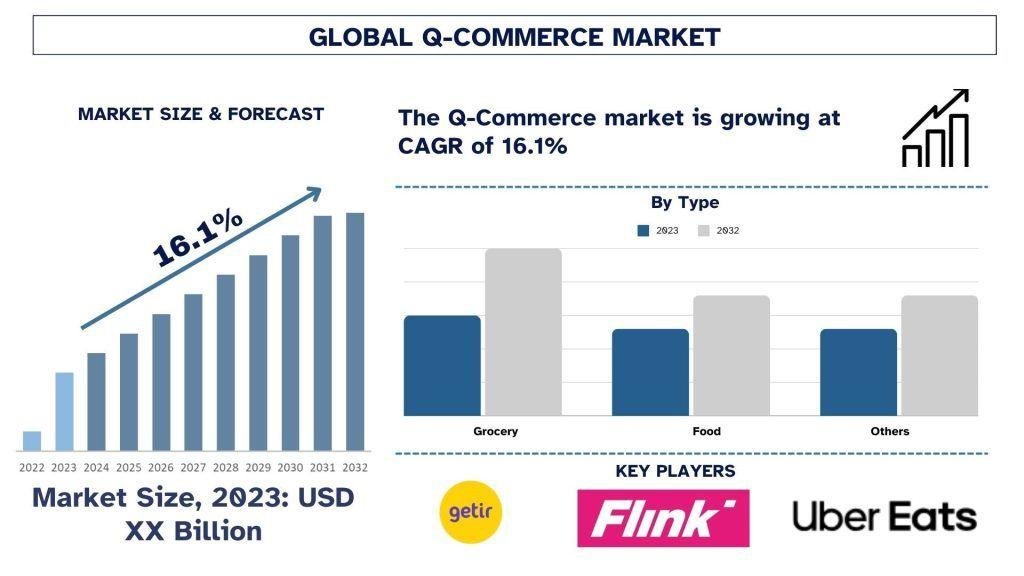The Q-Commerce Market was valued at approximately USD Billion in 2023 and is expected to grow at a robust CAGR of around 16.1% during the forecast period 2024-2032
According to a new report by UnivDatos, the Q Commerce Market is expected to reach
USD billion by 2032 by growing at a CAGR of ~16.1%. Consumers in the present-day business environment require
quick and easy solutions implying that the rate of the business process
delivery must be relatively higher. To address these
needs, a new and innovative business model known as Q-commerce or quick
commerce has emerged on the scene. It
sets delivery time ranges of anything between 10 and 30 minutes for several goods including
groceries and household items. Q-commerce can be easily described as a
harmonization of e-commerce and quick delivery, which employ technology, small
local warehouse outlets known as dark stores, and an optimal last-mile delivery
network. This model has proved to be very effective within large metropolitan areas in which consumers place great value on their time savings and availability of products.
Access sample report (including graphs, charts, and figures): https://univdatos.com/reports/q-commerce-market?popup=report-enquiry
Another factor that has contributed to the growing Q-commerce market in the global arena is the emergence of gig economies, urbanization, and an ever-broadening online shopping industry.
Dominating Regions
Although the
Q-commerce platform is on the rise across the world, specific countries are way ahead in Q-commerce
integration. These regions, because of large populations, strong and prevalent
ICT, and consumers’ current behaviors have indeed shaped the rest of the world.
North America: The U.S remains one of the world’s largest Q-commerce markets because of the very high uptake of
e-commerce, and a vibrant gig economy. Currently, these markets have been exploited
through the Q-commerce companies
that include GoPuff, DoorDash, and Instacart among others that operate in major cities.
Aiming for convenience with an ever-increasing fondness of quick deliveries,
together with well-developed last-mile logistics providers, has placed the U. S. among the leaders of the
Q-commerce transformation.
Europe: The current
trend in Europe, especially in the sizeable metropolitan cities that include
London, Berlin, and Paris is the Q-commerce
market. These are some of the quick delivery services that have emerged in different countries across the continent; Gorillas, Flink, and Getir among others. Accessibility and the high population density
are compelling factors that make the European market perfect for Q-commerce.
Germany is followed by the UK where consumers have adopted and started
investing most in this field.
Click here to view the Report Description & TOC: https://univdatos.com/reports/q-commerce-market
Asia-Pacific: Another
player in Q-commerce is the Asia-Pacific region which has a rapidly evolving e-commerce market and a dense population in large cities. The Asian giants are
already facing the increase in this segment with Zomato and Dunzo providing
Q-commerce services in Indian cities. Such large players such as JD.com of China
can effectively influence consumers’ buying behavior of snack products. Now, JD
com and Meituan have extended the
concept of Q-commerce into their overall e-commerce panorama in a bid to unlock
the rising demand for fast deliveries.
Middle East and Latin America: Q-commerce
is also gaining ground in emerging markets including the Middle East and Latin
America. In the Middle Eastern region, nations such as the UAE and Saudi Arabia have taken up Q-commerce because of
high mobile usability and an increasing tendency towards online purchases. Likewise,
Latin American cities ranging from São Paulo and Mexico City are expecting
higher demand in quick delivery services.
Related Consumer Goods Market Research Reports:
Market: Current Analysis and Forecast (2024-2032)
HoReCa Market: Current Analysis and Forecast (2024-2032)
Commerce Market: Current Analysis and Forecast (2024-2032)
Traceability Market: Current Analysis and Forecast (2024-2032)
Automation Market: Current Analysis and Forecast (2024-2032)
Conclusion
Q-commerce is
redefining the way consumers shop by providing unparalleled convenience and
speed in product deliveries. While still in its early stages, this market is poised for substantial growth as consumer
demand for instant gratification continues to rise. The combination of urbanization,
changing lifestyles, and technological advancements is driving Q-commerce to
become a dominant force in the retail and logistics sectors.
As Q-commerce
evolves, companies must continue to innovate, particularly in areas like
sustainability, AI-driven logistics, and expanding product offerings. Moreover, addressing
challenges such as regulatory hurdles, high operational costs, and the need for
a flexible workforce will be critical for long-term success.
Ultimately,
Q-commerce is more than just a fleeting trend; it represents the future of
retail, where speed, convenience, and technology converge to meet the demands
of modern consumers on a global scale.
Contact Us:
UnivDatos
Email: contact@univdatos.com
Contact no: +1 978 7330253
Website: www.univdatos.com

